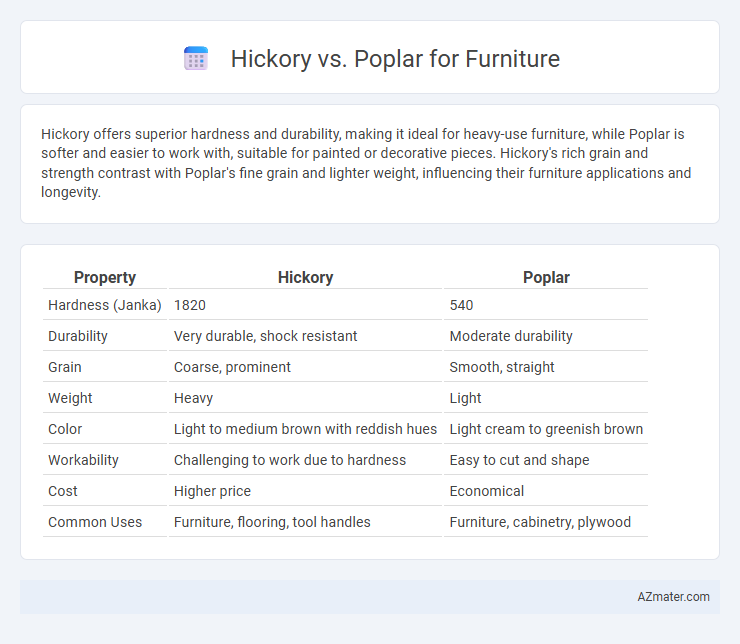Hickory offers superior hardness and durability, making it ideal for heavy-use furniture, while Poplar is softer and easier to work with, suitable for painted or decorative pieces. Hickory's rich grain and strength contrast with Poplar's fine grain and lighter weight, influencing their furniture applications and longevity.
Table of Comparison
| Property | Hickory | Poplar |
|---|---|---|
| Hardness (Janka) | 1820 | 540 |
| Durability | Very durable, shock resistant | Moderate durability |
| Grain | Coarse, prominent | Smooth, straight |
| Weight | Heavy | Light |
| Color | Light to medium brown with reddish hues | Light cream to greenish brown |
| Workability | Challenging to work due to hardness | Easy to cut and shape |
| Cost | Higher price | Economical |
| Common Uses | Furniture, flooring, tool handles | Furniture, cabinetry, plywood |
Introduction to Hickory and Poplar Woods
Hickory wood, known for its exceptional hardness and durability, is a popular choice for heavy-use furniture and flooring due to its high shock resistance and rich, varied grain patterns. Poplar wood, on the other hand, is a softer hardwood favored for its smooth texture and ease of staining, making it ideal for painted furniture and intricate woodworking projects. Both woods offer unique qualities: hickory excels in strength and rustic appeal, while poplar provides versatility and affordability for furniture making.
Appearance and Grain Patterns
Hickory furniture features a striking appearance with bold, contrasting grain patterns and a natural mix of light and dark tones, giving it a rustic and rugged aesthetic. Poplar presents a smoother, more uniform grain with subtle variations and a lighter, often greenish or yellowish hue, ideal for painted finishes and modern looks. Both woods offer distinct visual appeal, with hickory emphasizing strength and character, while poplar provides a clean, consistent surface.
Strength and Durability Comparison
Hickory wood exhibits exceptional strength and durability, making it one of the toughest hardwoods used in furniture construction with a Janka hardness of about 1,820 lbf. Poplar, while more affordable and easier to work with, has a significantly lower Janka hardness of approximately 540 lbf, indicating less resistance to dents and wear. For furniture requiring long-lasting structural integrity, hickory is the superior choice due to its dense grain and robust toughness.
Workability and Ease of Use
Hickory offers exceptional strength and density, making it more challenging to work with hand tools but ideal for durable furniture pieces. Poplar is softer and easier to cut, shape, and sand, providing greater workability for intricate designs and faster project completion. Both woods are versatile, but Poplar's ease of use often appeals to beginners and those prioritizing smooth finishes.
Cost Differences: Hickory vs Poplar
Hickory furniture typically costs more than poplar due to its superior hardness, durability, and distinctive grain patterns that enhance longevity and aesthetic appeal. Poplar is a budget-friendly option favored for its affordability and ease of painting, making it ideal for cost-sensitive projects or painted finishes. The price differential between hickory and poplar can range from 30% to 70%, with hickory commanding a premium in both raw lumber and finished furniture pieces.
Environmental Impact and Sustainability
Hickory and poplar differ significantly in environmental impact and sustainability when used for furniture. Hickory is a dense hardwood known for durability and slow growth, which may lead to longer replenishment cycles and higher environmental strain if not sourced responsibly. Poplar, a fast-growing, renewable soft hardwood, generally offers a more sustainable option due to quicker regrowth rates and lower ecological footprint in managed forests.
Finishing and Staining Qualities
Hickory offers exceptional finishing qualities due to its dense grain and natural color variations, allowing stains to highlight its unique patterns and produce a rich, rustic appearance. Poplar, with its smooth texture and lighter color, accepts paint and stains evenly but tends to lack the depth and complexity that characterize hickory finishes. For furniture projects requiring a durable finish with warm, contrasting tones, hickory is preferred, while poplar suits pieces benefiting from uniform, paint-friendly surfaces.
Suitability for Various Furniture Types
Hickory's dense grain and exceptional hardness make it ideal for heavy-use furniture like dining tables, chairs, and cabinets requiring durability and resistance to wear. Poplar's softer texture and fine, straight grain suit it well for painted furniture, intricate carvings, and indoor pieces such as bookcases and decorative accents where strength is less critical. Both woods offer versatility, but choosing between them depends on the desired finish, durability, and furniture function.
Maintenance and Longevity
Hickory offers superior durability and resistance to wear, making it ideal for furniture that endures heavy use, with relatively low maintenance requiring occasional cleaning and oiling to preserve its natural hardness. Poplar, while softer and more vulnerable to dents and scratches, demands regular upkeep such as refinishing or protective coatings to maintain its appearance over time. Choosing hickory enhances longevity and reduces long-term maintenance efforts compared to poplar's more frequent care needs in furniture applications.
Final Recommendations: Which Wood to Choose?
Hickory offers superior durability and strength, making it ideal for heavy-use furniture that requires long-lasting resilience. Poplar provides a smoother finish and is easier to paint, perfect for budget-friendly, decorative pieces with less wear and tear. Choose Hickory for robust, heirloom-quality furniture and Poplar for affordable, stylish items with customizable finishes.

Infographic: Hickory vs Poplar for Furniture
 azmater.com
azmater.com